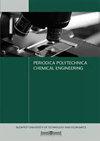624型毛细管柱的比较
IF 1.8
4区 工程技术
Q3 ENGINEERING, CHEMICAL
引用次数: 0
摘要
本研究对7根624型毛细管柱进行了研究。所有色谱柱的长度、内径、膜厚均相同(30 m × 0.32 mm × 1.0µm)。但是,它们是由不同的制造商生产的,或者是同一制造商生产的,但批次不同。尽管制造商将它们推荐为“等效列”,但即使在同一制造商生产的列的情况下,这种等效性也不普遍。我们的检验标准集中在色谱柱的定量测定能力上。自制的柱测试混合物被编译来表示所有的二级相互作用,可以发生在分析物和固定相之间。虽然理论上这些色谱柱具有相同的固定相质量,但它们不能产生相同的色谱图。除了色谱柱的来源和批次不同之外,“色谱柱的历史”同样会导致不同的峰对称性、保留顺序,甚至峰面积的不同,从而影响定量测定。我们用有效碳数(ECN)和定量限(LoQ)值对这种定量测定能力进行了量化。根据我们的结果,可达到的LoQ和ECN值至少取决于固定相的起源和实际状态,而不是要优化的测量条件。在我们的论文中,我们证明了不同公司和/或不同背景提供的相同固定相可以影响我们的检测限和检测器响应的程度,即使相关色谱在理论上具有相同的化学结构。本文章由计算机程序翻译,如有差异,请以英文原文为准。
Comparison of 624-type Capillary Columns
In our research, seven 624-type capillary columns were investigated. All the columns were the same in length, internal diameter, and film thickness (30 m × 0.32 mm × 1.0 µm). However, they were produced by different manufacturers or the same manufacturer but in different batches. Even though the manufacturers recommend them as "equivalent columns" this equivalence did not prevail even in the case of columns produced by the same manufacturer. Our examination criteria centered on the quantitative determination ability of the columns. A homemade column test mixture was compiled to represent all the second-order interactions that can occur between the analyte and stationary phase. Although theoretically these columns have the same stationary phase quality, they did not result in the same chromatograms. In addition to the origin and batch of the column, the "history of the column" contributes likewise to the different peak symmetry, retention order, and even peak areas that affect the quantitative determination. We quantified this quantitative determination ability with the effective carbon number (ECN) and the Limit of Quantitation (LoQ) values. Based on our results the attainable LoQ and ECN values depend at least as much on the origin and actual state of the stationary phase as on the measurement conditions to be optimized. In our paper, we demonstrate the extent to which the same stationary phases offered by different companies and/or different backgrounds can influence our detection limit and detector response even if the relevant columns have theoretically the same chemical structure.
求助全文
通过发布文献求助,成功后即可免费获取论文全文。
去求助
来源期刊

Periodica Polytechnica Chemical Engineering
ENGINEERING, CHEMICAL-
CiteScore
3.10
自引率
7.70%
发文量
44
审稿时长
>12 weeks
期刊介绍:
The main scope of the journal is to publish original research articles in the wide field of chemical engineering including environmental and bioengineering.
 求助内容:
求助内容: 应助结果提醒方式:
应助结果提醒方式:


